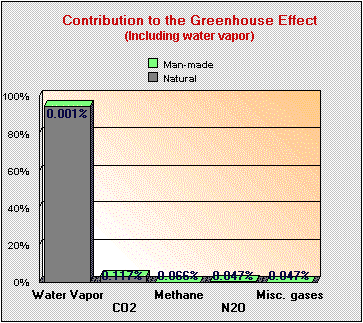Yes they are all reasons, but deforestation is a primary reason as well.
No it is not. Stop spouting your uneducated crap 'Koji'.
The contribution of human activity to the greenhouse effect as a contributor to radiative forcing and global warming is 0.28% -- 5.53% if water vapour, the earth's most abundant and significant greenhouse gas (at 95%) is not taken into account - which is what scientists, proponents of biofuels and the alternative fuels industry, and the viscerals championing the 'great human-induced global warming catastrophe' resort to to exaggerate human greenhouse gas contributions.
Water vapor is 99.999% of natural origin. Other atmospheric greenhouse gases: carbon dioxide (CO2), methane (CH4), nitrous oxide (N2O), and the miscellaneous other gases (CFC's, etc.), are also predominantly of natural origin (except for the last, which is mostly anthropogenic). However, the actual contribution of carbon dioxide and these latter greenhouse gases to the greenhouse effect is so small that human-induced emissions are
dwarfed in comparison to natural sources. Here is a data-graph compiled detailing actual human contribution from activities like deforesting, farming, manufacturing, etc. from scientific data in a five-stage synopsis:
The following is from a United States D.O.E. study on greenhouse gas emissions with numbers states in parts-per-billion. It however selectively leaves out water vapour and has not corrected for actual Global Warming Potential (GWP) of each gas.
These are however the statistics those who resort to the 'scientific method' would employ to expedite the benefits accruing from disseminated concern about 'startling human greenhouse gas emissions':
- Man-made and natural carbon dioxide (CO2) comprises 99.44% of all greenhouse gas concentrations (368,400 / 370,484 )--(ignoring water vapor).
However, also from the table:
- Anthropogenic (man-made) CO2 additions comprise (11,880 / 370,484) or 3.207% of all greenhouse gas concentrations, (ignoring water vapor).
- Total combined anthropogenic greenhouse gases comprise (12,217 / 370,484) or 3.298% of all greenhouse gas concentrations, (ignoring water vapor).
However, the various greenhouse gases are
not equal in their respective heat-retention properties, so that to remain statistically relevant, percentage concentrations must be converted to percentage contributions via GWP multipliers relative to Co2. Geocraft.com has a brilliant table in this regard modelled in the same format as the previous D.O.E. table for comparative convenience:
Now compare this to the above:
- Total carbon dioxide (CO2) contributions are reduced to 72.37% of all greenhouse gases: i.e. 368,400 / 509,056 - (ignoring water vapor).
- Anthropogenic (man-made) CO2 contributions are reduced to 11,880 / 509,056 ppb or 2.33% of total greenhouse gases, (ignoring water vapor).
- Total combined anthropogenic greenhouse gas emissions reduce to 28,162 / 509,056 ppb or 5.53% of all greenhouse gas contributions, (ignoring water vapor).
- Relative to carbon dioxide the other greenhouse gases cumulatively comprise about 27.63% of the greenhouse effect (ignoring water vapor) but only about 0.56% of total greenhouse gas concentrations.
To summarize differently, methane, nitrous oxide, chloro-fluoro-carbons and other miscellaneous gases account for about 50 times the equivalent concentrations of CO2 in the atmosphere: that is, they are about 50 times more potent than carbon dioxide as a net irradience-inducing greenhouse gas.
Now, factor water vapour into the contention and the equation changes dramatically. Also from Geocraft:
Total atmospheric carbon dioxide (CO2) - both man-made and natural - accounts for about 3.62% of the overall greenhouse effect. The most common greenhouse gas, Water Vapour, is responsible for about 95% of the effect. This is common knowledge among climatologists, but among special interest groups, lobby groups, NGO's with (yes) vested interests, and uninformed reporters, this is unacknowledged, ignored or underemphasized altogether.
To account for the human aspect of the non-water vapour greenhouse gas concentrations, the following is (mean-adjusted) scientific data compiled in pie charts from various statistical sources and geographical studies:
And finally, to calculate the proportion of the greenhouse effect due to human activity like mining, transportation, deforesting, etc., multiply the product of the adjusted CO2 contribution to greenhouse gases with percentage CO2 concentration from anthropogenic sources: 0.03618 X 0.03225 or 0.117% of net irradience
due to atmospheric CO2 from human activity. The most important fallout of deforestation is not 'global warming', but topographical and soil erosion.
Including water vapour and statistically cumulating for the human aspect of ALL greenhouse gas emissions to calculate the human contribution to the greehnouse effect as a whole:
As you can see, the anthropogenic contribution to the statistically correct total greenhouse gas effect (including water vapour) is approximately 0.28%. Furthermore, Aanthropogenic (man-made) CO2
contributions (adjusted for heat retentiveness) cause only about 0.117% of Earth's greenhouse effect.
Watch for the research of
Wallace Broecker, a respected American goechemist at Columbia's Earth Observatory. His research indicates that air reaching glaciers during the last Ice Age had less than half the water vapor content of today. Such increases in atmospheric moisture during our current interglacial period would have played a far greater role in global warming than carbon dioxide or other minor gases.







